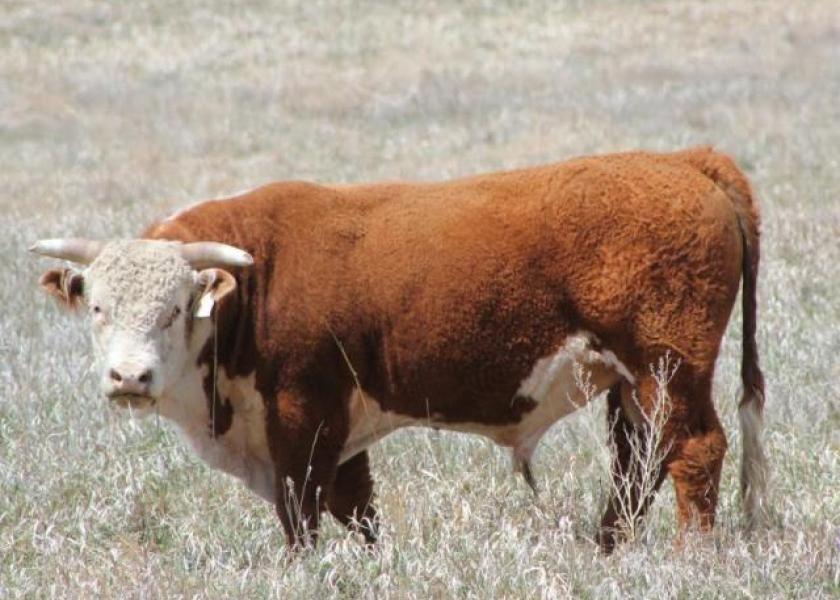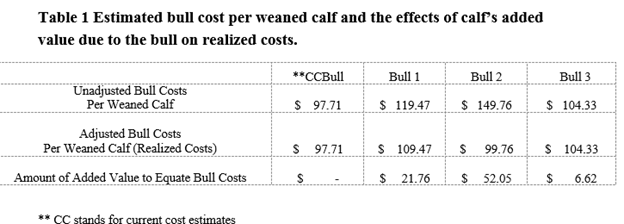Buying Bulls by Value

By: Matt Stockton University of Nebraska-Lincoln Extension
Selecting and buying the right bull for your herd is a complex question involving many factors including who you are, the type of cows in your herd, and the type of calves you are marketing. If you are only interested in producing terminal market animals you would likely select a herd sire strictly for growth and carcass qualities. Whereas if you are marketing weaned calves, and retain replacement females you may be more likely to focus on those bulls with maternal traits.
This article has no advice or recommendation about which type or kind of bull to purchase, but zeros in on comparing value differences among bulls of the same type. This is done using the Bull Value Cow-Q-Lator. This tool is in spreadsheet form and assumes that the user is comparing value or looking at purchasing bulls that are of the type they deem important but wishing to objectively decide among them utilizing the tool to capture performance indicators, knowledge and experience. This is similar to what many producers already do in their head but is more formal since the information in the producers head must be turned into dollar values and entered into the tool. The bull buyer must be willing to objectively value in dollars what they believe each bull will provide in the form of added calf values, both genetically (breeding) and/or phenotypically (performance).
Comparing the actual prices paid for bulls is only part of the equation. Including expected returns for each bull makes it more complete. One way to evaluate among possible replacement bulls is to compare their purchase costs minus the differences in the value of their calves. This is the approach taken in the Bull Value Cow-Q-Lator.
To illustrate how this decision tool might perform let’s use an example. Suppose a buyer attends a bull sale where they find 3 acceptable herd sire candidates to purchase. These bulls are identified as 1, 2 and 3. The 3 bulls are of varying quality, each has a unique EPD and physical characteristics which causes the buyer to value each of them differently. Since they are to be sold in an auction, you estimate that they are likely to sell for the following amounts: Bull 1 ($6,000), Bull 2 ($8,000), and Bull 3 ($5,000). It is expected that these bulls cost about the same to maintain and have the same expected longevity (death, injury, reproductive performance, etc.,), the only differences would be the ownership costs, depreciation and the added value of the calves.
Our example uses annual individual bull costs of $750 for feed, a 6% expected rate of return on investment, 4 years of serviceable life, 25 cows bred per year, a 110% replacement cost, a 2% chance of death and a 5% chance of injury, $300 of non-feed costs (vet, medicine, etc.,), and $120 of miscellaneous expense (labor, management, transportation). The expected average value added for each calf weaned over the current bull battery is estimated to be $10 more for Bull 1, $50 more for Bull 2 and $0 more for Bull 3. The expected calving rate for this herd is 87% regardless of which bull is used.
These values were entered into the Bull Value Cow-Q-Lator, found here, and resulted in three different unadjusted costs per weaned calf, which were $119.47 for Bull 1, $149.76 for Bull 2, and $104.33 for Bull 3, these are listed in the first row of Table 1. If costs were all that are considered, Bull 3 has the lowest annual unadjusted cost per weaned calf of $104.33. However, if the expected average value added by each bull is included in the analysis ($10 more for Bull 1, $50 more for Bull 2, and $0 more for Bull 3), Bull 2 becomes the best buy since the adjusted costs per weaned calf of $99.76 is lower than all other bulls. Adjusted cost is equal to unadjusted costs per weaned calf, $149.76, minus the added value of the weaned calf, $50. This adjusted cost is more than $4 per calf less than Bull 3 and more than $9 less than Bull 1. The adjusted results are recorded in the second row of Table 1.
Note that the CCBull column in Table 1 has the lowest unadjusted and adjusted cost and represents an estimate of the user’s current bull costs. This column indicates that current production costs are lower than any of the 3 bulls considered in the example for purchase. The last row in Table 1 shows that the estimated added value of calves from each of the bulls needed to keep cost constant. The added value per calf needed is $21.76, $52.05 and $6.62 for Bulls 1, 2, and 3 respectively. Any amount less than this value would result in an increase in net breeding cost. To demonstrate this point, Bull 1, purchased for $6000, has an expected $119.47 unadjusted cost per weaned calf and a $109.47 adjusted cost per weaned calf, due to a $10 expected added value of the calf would require an additional $11.76 added calf value to keep net breeding cost unchanged from estimated current net breeding costs of $97.71.
Another way this worksheet might be useful is use it to estimate the purchase price of a bull or set of bulls while maintaining a designated net breeding cost. To illustrate how this might be done suppose the same buyer from above wants to keep adjusted costs per weaned calf at the same level as their estimated current costs, the CCBull column in Table 1. In this case the buyer wishes to determine what the bull/s purchase price/s would be in order to maintain current net breeding costs. These cost estimates can be simply obtained by changing the bull purchase price/s for the selected animal/s, until their adjusted costs per weaned calf matches the CCBull’s adjusted per weaned calf costs (Row 2, Table 1). Using this technique along with the information from the first example, it is estimated that Bull 1 would be priced at $5,223, Bull 2 at $7,865 and Bull 3 at $4,563. See Table 2. These prices would be the maximum the buyer should be willing to pay for these bulls if the designated goal costs (net breeding costs) are to be maintained.
Whether you use this worksheet or develop something else when purchasing your herd sire, it is important to remember to try and include an accurate estimate of the added value to production gained or lost by using that sire as well as knowing the total purchase costs. This may require some effort since not all benefits and costs are easily measured or estimated. To accomplish this, each animal purchase should be as measured as objectively as possible. The closer these estimates reflect reality, the better are the chances that the decisions made using that information will achieve the desired results.
To obtain a copy of this spreadsheet click here, then select the red hyperlink titled “Bull Value Cow-Q-Lator”. Click on this hyperlink to download the decision tool. This decision aid requires the Microsoft Excel® program.








